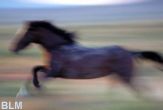
The remnants of what could be an ancient corral for keeping horses have been unearthed in northern Kazakhstan. The finding suggests the Botai culture living in the region 5,600 years ago didn't just hunt the creatures for meat, but were domesticating them, too.
Researchers found the remnants of 54 ancient homes and dozens of fence-post moulds where vertical posts once stood at a site called Krasnyi Yar. Some of the moulds were arranged circularly, as might be expected of a corral.
Soil in the area had chemical compositions matching what would be expected from Earth once enriched by horse manure, which is abundant in phosphorous, potassium and nitrogen. Soil at Krasnyi Yar was rich in all of these elements except nitrogen. This, too, would be expected if the soil was old, since nitrogen typically dissolves over time into groundwater and the atmosphere.
The Botai are not thought to have kept sheep or cattle, so the researchers ruled these animals out as sources of the manure, and the geochemical signature of the samples did not match human wastes.
A special place in Botai culture
The Botai are known to have had contact with horses, however. The discovery of arrowheads and horse bones at settlements suggest the Botai hunted horses for food, but scientists didn't know if they were also domesticating the creatures. If the Botai were using equipment such as bridles, leads and hobbles, they likely made them using horse hide, which would have rotted away long ago. The invention of saddles and metal bits—which have better chances of being preserved—were still centuries away.
From 3600 to 2300 B.C., the Botai culture lived in the steppe environment of Kazakhstan, where temperatures can reach subzero during winters. Domesticated horses could have weathered the deep chill, allowing the Botai people to stay put all-year round.
Get the world’s most fascinating discoveries delivered straight to your inbox.
"Horses can survive ice storms and don't need heated barns or winter fodder," said co-researcher Sandra Olsen of the Carnegie Museum of Natural History in Pittsburgh.
Sheep and cattle are not well suited for sub-zero climates and would have kept the Botai on the move.
In addition, domesticated horses would have supplied the Botai with meat year-round and vitamin-rich mare's milk from spring through fall. There is also evidence that the Botai were hauling lots of heavy materials, like rocks and large skulls, over long distances.
"You'd need a beast of burden, and there wouldn't have been too many that you could domesticate at that time," said Rosemary Capo, a geologist at the University of Pittsburgh involved in the study.
Not the first
As old as the Botai culture was, it's unlikely they were the first humans to domesticate horses, the researchers said.
"The very first horse domestication was probably a bit earlier in the Ukraine or western Russia," Olsen said. "Then some horse-herders migrated east to Kazakhstan."
The researchers plan to look for traces of fat and other molecules in the Krasnyi Yar soil that could be linked to horses.
The team's findings were presented this week at the Annual Meeting of the Geological Society of America in Philadelphia. Also involved in the study were University of Pittsburgh geologist Michael Rosenmeier and undergraduates Andrew Stiff and James Gardiner.
- The Secret of Fast Horses
- The Real History of Horses
- Images: The World's Biggest Beasts
- Climate Change, Not Humans, Killed Large Beasts


